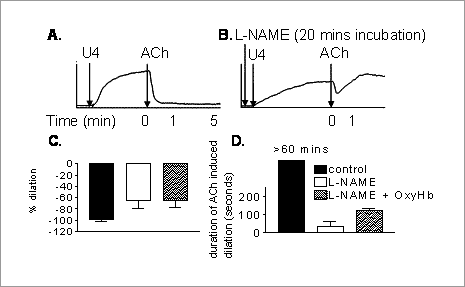Temporal relationship between endothelium derived nitric oxide and ’EDHF’ The identity of Endothelium Derived Hyperpolarizing Factor (EDHF) is yet to be resolved conclusively. However, it is increasingly stated that EDHF is the major factor involved in vasodilation in small arteries, and that nitric oxide has little contribution to the overall vascular tone in these vessels (Coleman et al, 2004). In the current study we have compared the effects of NO synthase inhibition on amplitude and duration of endothelium dependent dilator response in rat second order mesenteric vessels. Male Wistar rats (200 ± 15.4g) were killed by lethal exposure to CO2. Second order mesenteric arteries were mounted in isometric wire myographs, normalized and endothelium confirmed as described previously (Harrington and Mitchell, 2004). Arteries were pre-contracted with EC80 U46619 (3x 10-7M) and dilated with 3x 10-6M Acetylcholine (figure A). Both the level of vasodilation and the time taken to re-contract to pre-dilatory levels were recorded. Some arteries were incubated with 10-4M L-NAME or L-NAME plus oxygenated hemoglobin (OxyHb) for 20 minutes prior to the addition of acetylcholine. Acetylcholine induced a sustained vasodilator response which lasted for more than 1 hour. When vessels were pre-treated with L-NAME the amplitude of acetylcholine induced dilation was modestly reduced (Figure B and C) however the duration of the dilation was dramatically inhibited (Figure B and D). Similar results were obtained when OxyHb was included together with the L-NAME.
Acetylcholine (ACh) induces sustained dilation of U46619 (U4) contracted vessels. (B) Pretreatment with L-NAME or L-NAME plus OxyHb reduced the duration of ACh induced dilation (B and D) with only modest effects on amplitude (C), (n=4) When amplitude of response was considered the contribution of NO to the dilator effects of acetylcholine was modest, however when duration of response was considered, more than 95% of acetylcholine induced endothelium dependent dilation could be attributed to the release of NO. This data challenges the notion that in small mesenteric arteries of the rat, NO is a redundant pathway (in favor of EDHF). The transitory dilatory response which remains when all NO is blocked (by the combination of L-NAME plus OxyHb) is however, likely to be EDHF (please see
Harrington et al 2005, this meeting).
|


